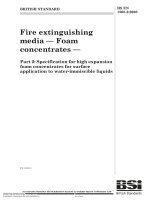Bsi bs en 61966 2 5 2008
Bạn đang xem bản rút gọn của tài liệu. Xem và tải ngay bản đầy đủ của tài liệu tại đây (1018.37 KB, 26 trang )
BS EN 61966-2-5:2008
BSI Standards Publication
Multimedia systems and
equipment — Colour
measurement and
management —
Part 2-5: Colour management —
Optional RGB colour space —
opRGB
BRITISH STANDARD
BS EN 61966-2-5:2008
National foreword
This British Standard is the UK implementation of EN 61966-2-5:2008. It
is identical to IEC 61966-2-5:2007.
The UK participation in its preparation was entrusted to Technical Committee
EPL/100, Audio, video and multimedia systems and equipment.
A list of organizations represented on this committee can be obtained on
request to its secretary.
This publication does not purport to include all the necessary provisions of a
contract. Users are responsible for its correct application.
© BSI 2010
ISBN 978 0 580 57514 3
ICS 17.180.20; 33.160.60
Compliance with a British Standard cannot confer immunity from
legal obligations.
This British Standard was published under the authority of the Standards
Policy and Strategy Committee on 28 February 2010
Amendments issued since publication
Amd. No.
Date
Text affected
BS EN 61966-2-5:2008
EN 61966-2-5
EUROPEAN STANDARD
NORME EUROPÉENNE
EUROPÄISCHE NORM
January 2008
ICS 17.180.20; 33.160.60
English version
Multimedia systems and equipment Colour measurement and management Part 2-5: Colour management Optional RGB colour space opRGB
(IEC 61966-2-5:2007)
Mesure et gestion de la couleur
dans les systèmes
et appareils multimédia Partie 2-5: Gestion de la couleur Espace chromatique RVB optionnel opRVB
(CEI 61966-2-5:2007)
Multimediasysteme und -geräte Farbmessung und Farbmanagement Teil 2-5: Farbmanagement Optionaler RGB-Farbraum opRGB
(IEC 61966-2-5:2007)
This European Standard was approved by CENELEC on 2007-12-01. CENELEC members are bound to comply
with the CEN/CENELEC Internal Regulations which stipulate the conditions for giving this European Standard
the status of a national standard without any alteration.
Up-to-date lists and bibliographical references concerning such national standards may be obtained on
application to the Central Secretariat or to any CENELEC member.
This European Standard exists in two official versions (English and German). A version in any other language
made by translation under the responsibility of a CENELEC member into its own language and notified to the
Central Secretariat has the same status as the official versions.
CENELEC members are the national electrotechnical committees of Austria, Belgium, Bulgaria, Cyprus, the
Czech Republic, Denmark, Estonia, Finland, France, Germany, Greece, Hungary, Iceland, Ireland, Italy, Latvia,
Lithuania, Luxembourg, Malta, the Netherlands, Norway, Poland, Portugal, Romania, Slovakia, Slovenia, Spain,
Sweden, Switzerland and the United Kingdom.
CENELEC
European Committee for Electrotechnical Standardization
Comité Européen de Normalisation Electrotechnique
Europäisches Komitee für Elektrotechnische Normung
Central Secretariat: rue de Stassart 35, B - 1050 Brussels
© 2008 CENELEC -
All rights of exploitation in any form and by any means reserved worldwide for CENELEC members.
Ref. No. EN 61966-2-5:2008 E
BS EN 61966-2-5:2008
EN 61966-2-5:2008
-2-
Foreword
The text of document 100/1212/CDV, future edition 1 of IEC 61966-2-5, prepared by technical area 2,
Colour measurement and management, of IEC TC 100, Audio, video and multimedia systems and
equipment, was submitted to the IEC-CENELEC parallel Unique Acceptance Procedure and was
approved by CENELEC as EN 61966-2-5 on 2007-12-01.
The following dates were fixed:
– latest date by which the EN has to be implemented
at national level by publication of an identical
national standard or by endorsement
(dop)
2008-09-01
– latest date by which the national standards conflicting
with the EN have to be withdrawn
(dow)
2010-12-01
Annex ZA has been added by CENELEC.
__________
Endorsement notice
The text of the International Standard IEC 61966-2-5:2007 was approved by CENELEC as a European
Standard without any modification.
__________
BS EN 61966-2-5:2008
-3-
EN 61966-2-5:2008
Annex ZA
(normative)
Normative references to international publications
with their corresponding European publications
The following referenced documents are indispensable for the application of this document. For dated
references, only the edition cited applies. For undated references, the latest edition of the referenced
document (including any amendments) applies.
NOTE When an international publication has been modified by common modifications, indicated by (mod), the relevant EN/HD
applies.
Publication
Year
Title
EN/HD
Year
IEC 60050-845
1987
International Electrotechnical Vocabulary
(IEV) Chapter 845: Lighting
-
-
ISO 3664
2000
Viewing conditions - Graphic technology
and photography
-
-
ISO/CIE 10527
1991
CIE standard colorimetric observers
-
-
CIE 15
2004
Colorimetry
-
-
CIE 17.4
1987
International Lighting Vocabulary
-
-
CIE 122
1996
The relationship between digital and
colorimetric data for computer-controlled
CRT displays
-
-
CIE 1931
-2)
CIE XYZ color space
-
-
1)
2)
1)
ISO/CIE 10527:1991 is replaced by ISO 10527:2007.
Undated reference.
BS EN 61966-2-5:2008
–2–
61966-2-5 IEC:2007(E)
CONTENTS
INTRODUCTION.....................................................................................................................5
1
Scope ...............................................................................................................................6
2
Normative references .......................................................................................................6
3
Terms and definitions .......................................................................................................6
4
Reference conditions ........................................................................................................8
5
4.1 Reference image display system characteristics ...................................................... 8
4.2 Reference viewing conditions ..................................................................................8
4.3 Reference observer .................................................................................................9
Encoding transformations .................................................................................................9
5.1
5.2
5.3
Introduction .............................................................................................................9
Transformation from opRGB values to CIE 1931 XYZ values ...................................9
Transformation from CIE 1931 XYZ values to opRGB values ...................................9
Annex A (normative) Transformation between opRGB values and YCC values for
image compression ............................................................................................................... 11
Annex B (informative) Example transformation between opRGB values and sYCC
values ................................................................................................................................... 14
Annex C (informative) Example interpretation for colour image encoding specifications ........ 19
Bibliography.......................................................................................................................... 21
Table 1 – CIE chromaticities and CIE standard illuminant .......................................................8
BS EN 61966-2-5:2008
61966-2-5 IEC:2007(E)
–5–
INTRODUCTION
The colour gamut for various image I/O devices has been gradually extended in recent years.
IEC 61966-2-1 “Multimedia Systems and Equipment – Colour Measurement and
Management – Part 2-1: Colour Management – Default RGB Colour Space – sRGB” is the
International Standard issued in 1999, based on the colour characteristics of contemporary
CRT displays.
Subsequently, displays with a wider colour gamut have been commercialized in order to better
cover the colour gamut that is available for digital still cameras, printers and other devices.
This International Standard specifies a colour image encoding similar to the sRGB encoding,
but based on a wider gamut colour space than sRGB. The rendering of the image for specific
applications is beyond the scope of this standard. A display that has a colour gamut wider
than conventional displays has been selected as the “Reference image display system
characteristics” in this standard. These wider colour gamut displays provide advantages in
commercial printing industry workflows and are intended to be used by professional
photographers, prepress industry including DTP and designers.
.
BS EN 61966-2-5:2008
–6–
61966-2-5 IEC:2007(E)
MULTIMEDIA SYSTEMS AND EQUIPMENT –
COLOUR MEASUREMENT AND MANAGEMENT –
Part 2-5: Colour management –
Optional RGB colour space –
opRGB
1
Scope
This part of IEC 61966 is applicable to the encoding and communication of RGB colours
optionally used in computer systems and similar applications by defining encoding
transformations for use in defined reference conditions.
If actual conditions differ from the reference conditions, additional rendering transformations
may be required. Such additional rendering transformations are beyond the scope of this
standard.
2
Normative references
The following referenced documents are indispensable for the application of this document.
For dated references, only the edition cited applies. For undated references, the latest edition
of the referenced document (including any amendments) applies.
IEC 60050(845):1987, International Electrotechnical Vocabulary (IEV) – Chapter 845:
Lighting / CIE 17.4:1987, International Lighting Vocabulary (Joint IEC/CIE publication)
ISO 3664:2000, Viewing conditions – Graphic technology and photography
ISO/CIE 10527:1991, CIE standard colorimetric observers
CIE 15:2004, Colorimetry, 3rd ed.
CIE 122:1996, The relationship between digital and colorimetric data for computer-controlled
CRT displays
CIE 1931, CIE XYZ color space
3
Terms and definitions
For the purposes of this document, the following terms and definitions apply. Definitions of
colour space, illuminance, luminance, tristimulus and other related lighting terms are provided
in IEC 60050(845).
3.1
ambient illuminance level
illuminance level due to lighting in the viewing environment, excluding that from the display,
measured in the plane of the display faceplate
BS EN 61966-2-5:2008
61966-2-5 IEC:2007(E)
–7–
3.2
ambient white point
coordinate point in the CIE 1931 XYZ chromaticity coordinate defined by ISO/CIE 10527 and
CIE 15.2 due to lighting in the viewing environment, excluding that from the display, measured
in the plane of the display faceplate
3.3
display illuminant white point
point in the CIE 1931 XYZ chromaticity diagram defined by ISO/CIE 10527 and CIE 15.2, at
which the red, green and blue intensities are at 100 %, measured in a direction perpendicular
to the display faceplate
3.4
display background
environment of the colour element, extending typically for about ten degrees from the edge of
the proximal field in all, or most, directions. When the proximal field is the same colour as the
background, the latter is regarded as extending from the edge of the colour element
considered
3.5
display black level
the luminance level characteristic measured in a direction perpendicular to the display
faceplate, including unwanted leak light through the faceplate and veiling glare from ambient
illumination, at which the red, green and blue intensities are at 0 %
3.6
veiling glare
light, reflected from an imaging medium, that has not been modulated by the means used to
produce the image
NOTE
In CIE 122, the veiling glare of a CRT display is referred to as ambient flare.
3.7
display model offset
parameter measured consistently with CIE 122, representing the black offset level of the
display grid voltage
3.8
display input/output characteristic
transfer characteristic relating the normalised digital code value and the normalised output
luminance as represented by a power function
3.9
display luminance level
luminance of the display measured consistently with CIE 122
3.10
display surround
field outside the background, filling the field of vision
3.11
display proximal field
immediate environment of the colour element considered, extending typically for about two
degrees from the edge of the colour element considered in all, or most, directions
BS EN 61966-2-5:2008
61966-2-5 IEC:2007(E)
–8–
4
Reference conditions
4.1
Reference image display system characteristics
The reference image display system is a computer controlled display and shall be as follows.
•
Display luminance level
160 cd/m 2
•
Display white point
x = 0,312 7, y = 0,329 0 (D65)
X W = 152,07
Y W = 160,00
Z W = 174,25
•
Display model offset (R, G and B)
0,0
•
Display input/output characteristic (R, G and B)
2,2
•
Display black level
0,4 cd/m 2
The CIE chromaticities for the red, green and blue reference display primaries, and for CIE
standard illuminant D65, are given in table 1.
Table 1 – CIE chromaticities and CIE standard illuminant
Red
Green
Blue
D65
x
0,640 0
0,210 0
0,150 0
0,312 7
y
0,330 0
0,710 0
0,060 0
0,329 0
z
0,030 0
0,080 0
0,790 0
0,358 3
The reference display characterization is based on the characterization in CIE 122. Relative
to this methodology, the reference display is characterised by the equation below, where
is the normalised digital count and VopRGB is the output normalised luminance.
′
VopRGB
(
)
′
VopRGB = VopRGB
+ 0,0 2,2
4.2
(1)
Reference viewing conditions
Specifications for the reference viewing environments are derived from ISO 3664 and shall be
as follows:
a) Reference background
for the background as part of the display screen,
the background is 20 % of the reference display
luminance level (32 cd/m 2 ); the chromaticity should
average to x = 0,312 7, y = 0,329 0 (D65).
b) Reference surround
20 % diffuse reflectance of the maximum reference
ambient illuminance level (4,07 cd/m 2 ); the
chromaticity should average to x = 0,345 7,
y = 0,358 5 (D50).
NOTE
This is the luminance of the adapting field.
BS EN 61966-2-5:2008
61966-2-5 IEC:2007(E)
–9–
c) Reference proximal field
20 % of the reference display luminance level
(32 cd/m 2 ); the chromaticity should average to
x = 0,312 7, y = 0,329 0 (D65).
d) Reference ambient illuminance level
64 lx.
e) Reference ambient white point
x = 0,345 7, y = 0,358 5 (D50).
4.3
Reference observer
The reference observer shall be the CIE 1931 two-degree standard observer from
ISO/CIE 10527.
5
5.1
Encoding transformations
Introduction
The encoding transformations between CIE 1931 XYZ values and N -bit RGB values provide
unambiguous methods for representing optimum image colorimetry when viewed on the
reference display in the reference viewing conditions by the reference observer. The CIE 1931
XYZ values are normalized by display luminance level and are scaled 0.0 to 1.0. The opRGB
tristimulus values are linear combinations of the normalized CIE 1931 XYZ values as
measured on the faceplate of the display. The non-linear opR ′ G ′ B′ values represent the
colorimetry of the image as displayed on the reference display.
5.2
Transformation from opRGB values to CIE 1931 XYZ values
The digital code values are converted to non-linear opR ′ G ′ B′ values.
This standard specifies a black digital count of 0 and a white digital count of 2 N − 1 for
N -bits/channel encoding. The resulting non-linear opR′ G ′ B′ values are formed according to
the following equations.
′
= R opRGB(N) ÷ ( 2 N − 1)
R opRGB
′
= G opRGB(N) ÷ ( 2 N − 1)
G opRGB
⎫
⎪⎪
⎬
⎪
⎪⎭
′
= B opRGB(N) ÷ ( 2 N − 1)
B opRGB
(2)
The non-linear opR ′ G ′ B′ values are transformed to CIE 1931 XYZ values as follows:
(
)2,2
′
)2,2
GopRGB = (GopRGB
′
)2,2
BopRGB = (BopRGB
′
RopRGB = RopRGB
⎫
⎪⎪
⎬
⎪
⎪⎭
(3)
and
⎡ X ⎤ ⎡0 ,576 7
⎢ ⎥ ⎢
⎢ Y ⎥ = ⎢0 ,297 3
⎢⎣ Z ⎥⎦ ⎢⎣0 ,027 0
5.3
0,185 6
0 ,627 4
0 ,070 7
0,188 2 ⎤ ⎡ RopRGB ⎤
⎥
⎥⎢
0 ,075 3 ⎥ ⎢GopRGB ⎥
0 ,991 3 ⎥⎦ ⎢⎣ BopRGB ⎥⎦
(4)
Transformation from CIE 1931 XYZ values to opRGB values
For 24 bit encoding (8-bit/channel), the opRGB tristimulus values can be computed using the
following relationship:
BS EN 61966-2-5:2008
61966-2-5 IEC:2007(E)
– 10 –
⎡ RopRGB ⎤ ⎡ 2,041 6
⎢
⎥ ⎢
⎢GopRGB ⎥ = ⎢− 0 ,969 2
⎢ BopRGB ⎥ ⎢ 0 ,013 4
⎣
⎦ ⎣
− 0 ,565 0
1,876 0
− 0 ,118 4
− 0 ,344 7 ⎤ ⎡ X ⎤
⎥⎢ ⎥
0 ,041 6 ⎥ ⎢ Y ⎥
1,015 2 ⎥⎦ ⎢⎣ Z ⎥⎦
(5)
other N-bit/channel encoding is supported ( N > 8 ), the relationship is defined as;
⎡ RopRGB ⎤ ⎡ 2,041 588
⎥ ⎢
⎢
⎢GopRGB ⎥ = ⎢− 0 ,969 244
⎢ BopRGB ⎥ ⎢ 0 ,013 444
⎦ ⎣
⎣
− 0,565 007
1,875 968
− 0 ,118 362
− 0 ,344 731 ⎤ ⎡ X ⎤
⎥⎢ ⎥
0 ,041 555 ⎥ ⎢ Y ⎥
1,015 175 ⎥⎦ ⎢⎣ Z ⎥⎦
(5')
In the RGB encoding process, negative opRGB tristimulus values and opRGB tristimulus
values greater than 1,00 are not retained. The luminance dynamic range and colour gamut of
RGB is limited to the tristimulus values between 0,0 and 1,0 by simple clipping.
The opRGB tristimulus values are transformed to non-linear opR ′ G ′ B′ values as follows:
(1,0 / 2,2)
′
= RopRGB
RopRGB
(1,0 / 2,2)
′
= GopRGB
GopRGB
′
=
BopRGB
⎫
⎪
⎪
⎬
⎪
⎪⎭
(1,0 / 2,2)
BopRGB
(6)
The non-linear opR ′ G ′ B′ values are converted to digital code values.
This standard specifies a black digital count of 0 and a white digital count of 2 N − 1 for
N -bits/channel encoding. The resulting RGB values are formed according to the following
equations where the round function rounds the resulting value to the nearest integer.
{
= round{( 2
= round{( 2
′
RopRGB(N) = round ( 2 N − 1) × RopRGB
GopRGB(N)
BopRGB(N)
N
N
′
− 1) × GopRGB
′
− 1) × BopRGB
}
}
}
⎫
⎪⎪
⎬
⎪
⎪⎭
(7)
BS EN 61966-2-5:2008
61966-2-5 IEC:2007(E)
– 11 –
Annex A
(normative)
Transformation between opRGB values and YCC
values for image compression
A.1
Transformation from opRGB values to YCC values for image compression
The digital code values are converted to non-linear opR ′ G ′ B′ values. This conversion scales
the digital code values by using the equation below, where WDC represents the white digital
count and KDC represents the black digital count.
(RopRGB(N) − KDC )
(WDC − KDC )
(
GopRGB(N) − KDC )
′
=
GopRGB
(WDC − KDC )
(
BopRGB(N) − KDC )
=
B′
⎫
⎪
⎪⎪
⎬
⎪
⎪
⎪⎭
′
=
RopRGB
(WDC − KDC )
opRGB
(A.1)
This standard specifies a black digital count of 0 and a white digital count of 2 N − 1 for N bits/channel encoding. The resulting non-linear opR ′ G ′ B′ values are formed according to the
following equations.
′
= RopRGB(N) ÷ ( 2 N − 1)
R opRGB
′
G opRGB
= G opRGB(N) ÷ ( 2 N − 1)
⎫
⎪⎪
⎬
⎪
⎪⎭
′
B opRGB
= BopRGB(N) ÷ ( 2 N − 1)
(A.2)
The non-linear opR ′ G ′ B′ values are transformed to YCC values for image compression as
follows:
⎡ YopRGB
⎤ ⎡ 0 ,299 0
′
⎢
⎥ ⎢
′
⎢CbopRGB
⎥ = ⎢− 0 ,168 7
⎢ CropRGB
⎥ ⎢ 0 ,500 0
′
⎣
⎦ ⎣
0,587 0
− 0 ,331 3
− 0 ,418 7
⎤
′
0 ,114 0 ⎤ ⎡ RopRGB
⎥
⎥⎢ ′
0 ,500 0 ⎥ ⎢GopRGB ⎥
⎥
′
− 0 ,081 3 ⎥⎦ ⎢⎣ BopRGB
⎦
(
)
′
) + 128 ]
= round[(255 × CbopRGB
′
) + 128 ]
= round[(255 × CropRGB
′
Y opRGB(8) = round 255 × YopRGB
CbopRGB (8)
CropRGB (8)
[( )
]
)+ 2 ]
= round[((2 − 1) × Cb ′
)+ 2 ]
= round[((2 − 1) × Cr ′
′
YopRGB(N) = round 2 N − 1 × YopRGB
CbopRGB(N)
CropRGB(N)
N
N
opRGB
opRGB
N −1
N −1
⎫
⎪
⎪
⎬
⎪
⎪⎭
(A.3)
(A.4)
⎫
⎪
⎪
⎬
⎪
⎪
⎭
(A.5)
BS EN 61966-2-5:2008
61966-2-5 IEC:2007(E)
– 12 –
A.2
Transformation from YCC for image compression values to opRGB values
The non-linear Y'Cb'Cr' values for image compression can be computed using the following
relationship:
(
) (WDC − KDC )
′
= (CbopRGB − Offset ) Range
CbopRGB
′
= (CropRGB − Offset ) Range
CropRGB
⎫
⎪⎪
⎬
⎪
⎪⎭
′
= YopRGB − KDC
YopRGB
(A.6)
For 24-bit encoding (8-bit/channel), WDC = 255, KDC = 0, Range = 255 and Offset = 128, the
relationship is defined as:
(
= (Cb
= (Cr
) (255 − 0) = Y
− 128 ) 255
− 128 ) 255
′
YopRGB
= YopRGB(8) − 0
′
CbopRGB
′
CropRGB
opRGB(8)
opRGB(8)
opRGB(8)
⎫
⎪
⎪
⎬
⎪
⎪⎭
255
(A.7)
24-bit encoding (8-bit/channel) should be the default YCC for image compression encoding bit
depth. Other bit depths may be unsupported for general use.
Where other N-bit/channel encoding is supported ( N > 8 ), the relationship is defined as:
′
= YopRGB(N)
YopRGB
(
= (Cr
(2
N
)
−1
) (2
) (2
′
= CbopRGB(N) − 2 N −1
CbopRGB
N
− 2 N −1
N
′
CropRGB
opRGB(N)
⎫
⎪
⎪
⎬
⎪
⎪
⎭
)
− 1)
−1
(A.7')
The non-linear Y′C b ′C r ′ for image compression values are transformed to the nonlinear
opR′G′B′ values as follows:
⎡ RopRGB
⎤ ⎡1,000 0
′
⎢
⎥ ⎢
′
⎢GopRGB
⎥ = ⎢1,000 0
⎢ BopRGB
⎥ ⎢1,000 0
′
⎣
⎦ ⎣
0 ,000 0
− 0 ,344 1
1,772 0
⎤
′
1,402 0 ⎤ ⎡ YopRGB
⎥
⎥⎢ ′
− 0 ,714 1 ⎥ ⎢CbopRGB ⎥
⎥
′
0 ,000 0 ⎥⎦ ⎢⎣ CropRGB
⎦
(A.8)
In opRGB encoding process, negative opRGB tristimulus values and opRGB tristimulus values
greater than 1,00 are not retained by simple clipping.
′
)
RopRGB(8) = round(255 × RopRGB
′
)
GopRGB(8) = round(255 × GopRGB
BopRGB(8)
′
)
= round(255 × BopRGB
⎫
⎪⎪
⎬
⎪
⎪⎭
(A.9)
For 24-bit encoding (8-bit/channel), the opRGB (8) values should be limited to a range from 0
to 255 after equation (A.9).
BS EN 61966-2-5:2008
61966-2-5 IEC:2007(E)
– 13 –
{
= round{(2
= round{(2
′
RopRGB(N) = round (2 N − 1) × RopRGB
GopRGB(N)
BopRGB(N)
N
N
′
− 1) × GopRGB
′
− 1) × BopRGB
}
}
}
⎫
⎪⎪
⎬
⎪
⎪⎭
(A.10)
For N-bit/channel encoding ( N > 8 ), the opRGB (N) values should be limited to a range from 0
to 2 N –1 after equation (A.10).
BS EN 61966-2-5:2008
61966-2-5 IEC:2007(E)
– 14 –
Annex B
(informative)
Example transformation between opRGB values and sYCC values
B.1
General
Since the opRGB and sYCC colour encodings have different colour gamut capabilities and
different reference display characteristics, it is not possible to define a single transform from
one to the other that will always produce optimal results. There will be preferential aspects to
the transform that may depend on the intended use case, and potentially even the images to
be converted. Different colour re-rendering and gamut mapping algorithms may be preferred
in different situations. However, in the absence of more sophisticated optimization, the
following example transformation may be used.
B.2
Example transformation from opRGB values to sYCC values
The digital code values are converted to non-linear opR′G′B′ values. This conversion scales
the digital code values by using the equation below, where WDC represents the white digital
count and KDC represents the black digital count.
(RopRGB(N) − KDC )
(WDC − KDC )
(
GopRGB(N) − KDC )
′
GopRGB
=
(WDC − KDC )
BopRGB(N) − KDC )
(
B′
=
⎫
⎪
⎪⎪
⎬
⎪
⎪
⎪⎭
′
RopRGB
=
(WDC − KDC )
opRGB
(B.1)
This standard specifies a black digital count of 0 and a white digital count of 2 N − 1 for
N -bits/channel encoding. The resulting non-linear opR′G′B′ values are formed according to
the following equations.
′
= RopRGB(N) ÷ (2 N − 1)
RopRGB
⎫
⎪⎪
⎬
⎪
⎪⎭
′
= G opRGB(N) ÷ (2 N − 1)
G opRGB
′
B opRGB
= BopRGB(N) ÷ (2
N
− 1)
(B.2)
The non-linear opR′G′B′ values are transformed to sRGB values as follows:
(
)2,2
′
)2,2
GopRGB = (GopRGB
′
)2,2
BopRGB = (BopRGB
′
RopRGB = RopRGB
⎫
⎪⎪
⎬
⎪
⎭⎪
(B.3)
and
⎡ RsRGB ⎤ ⎡ 1,398 4
⎢
⎥ ⎢
⎢GsRGB ⎥ = ⎢0 ,000 0
⎢⎣ BsRGB ⎥⎦ ⎢⎣0 ,000 0
− 0 ,398 4
1,000 0
− 0 ,042 9
0 ,000 0 ⎤ ⎡ RopRGB ⎤
⎥
⎥⎢
0 ,000 0 ⎥ ⎢GopRGB ⎥
1,042 9 ⎥⎦ ⎢⎣ BopRGB ⎥⎦
(B.4)
BS EN 61966-2-5:2008
61966-2-5 IEC:2007(E)
– 15 –
In the sYCC encoding process, negative sRGB tristimulus values and sRGB tristimulus value
greater than 1,0 are retained.
If R sRGB , G sRGB , B sRGB <-0,003 130 8
′
R sRGB
= −1,055 × ( − R sRGB ) (1,0 / 2,4 ) + 0,055
′
G sRGB
= −1,055 × ( −G sRGB ) (1,0 / 2,4 ) + 0,055
′
B sRGB
= −1,055 × ( − B sRGB ) (1,0 / 2,4 ) + 0,055
If −0,003 130 8 ≤ R sRGB , G sRGB , B sRGB
⎫
⎪⎪
⎬
⎪
⎪⎭
(B.5)
≤ 0,003 130 8
′
R sRGB
= 12,92 × R sRGB
′
G sRGB
= 12,92 × G sRGB
′
B sRGB
= 12,92 × B sRGB
⎫
⎪
⎬
⎪
⎭
(B.6)
If R sRGB , G sRGB , B sRGB >0,003 130 8
′
R sRGB
= 1,055 × ( R sRGB ) (1,0 / 2,4 ) − 0,055
′
G sRGB
= 1,055 × (G sRGB ) (1,0 / 2,4 ) − 0,055
′
B sRGB
= 1,055 × ( B sRGB ) (1,0 / 2,4 ) − 0,055
⎫
⎪⎪
⎬
⎪
⎪⎭
(B.7)
The relationship between non-linear sRGB and sYCC is defined as follows:
′
⎤ ⎡ 0,299 0
⎡ YsYCC
⎥ ⎢
⎢ ′
⎢CbsYCC ⎥ = ⎢− 0 ,168 7
⎥⎦ ⎢⎣ 0 ,500 0
⎢⎣ CrsYCC
′
0,587 0
− 0 ,331 3
− 0 ,418 7
′
0 ,114 0 ⎤ ⎡ RsRGB
⎤
⎥
⎥⎢ ′
0 ,500 0 ⎥ ⎢GsRGB ⎥
⎥⎦
′
− 0 ,081 3 ⎥⎦ ⎢⎣ BsRGB
(B.8)
Quantization for sYCC is defined as:
′
+ KDC ]
YsYCC = round[(WDC − KDC ) × YsYCC
′
) + Offset ]
CbsYCC = round[(Range × CbsYCC
′
) + Offset ]
CrsYCC = round[(Range × CrsYCC
⎫
⎪
⎬
⎪
⎭
(B.9)
For 24-bit encoding (8-bit/channel), the relationship is defined as:
′
′
]
+ 0] = round[255 × YsYCC
YsYCC(8) = round[(255 − 0 ) × YsYCC
′
) + 128]
CbsYCC(8) = round[(255 × CbsYCC
′
) + 128]
CrsYCC(8) = round[(255 × CrsYCC
⎫
⎪
⎪
⎬
⎪
⎪⎭
Where other N-bit/channel encoding is supported ( N > 8 ), the relationship is defined as:
(B.10)
BS EN 61966-2-5:2008
– 16 –
61966-2-5 IEC:2007(E)
[( )
]
)+ 2 ]
= round[((2 − 1) × Cb ′
)+ 2 ]
= round[((2 − 1) × Cr ′
⎫
⎪
⎪
⎬
⎪
⎪
⎭
′
YsYCC(N) = round 2 N − 1 × YsYCC
CbsYCC(N)
CrsYCC(N)
N
sYCC
N
N −1
N −1
sYCC
(B.11)
For N-bit/channel encoding ( N > 8 ), the sYCC (N) values should be limited to a range from 0 to
2 N -1 after equation (B.11).
B.3
Example transformation from sYCC values to opRGB values
The non-linear sY'Cb'Cr' values can be computed using the following relationship:
′
YsYCC
= (YsYCC − KDC ) (WDC − KDC )
′
CbsYCC
= (CbsYCC − Offset ) Range
′
CrsYCC = (CrsYCC − Offset ) Range
⎫
⎪
⎬
⎪
⎭
(B.12)
For 24-bit encoding (8-bit/channel), WDC = 255, KDC = 0, Range = 255 and Offset = 128, the
relationship is defined as;
(
= (Cb
= (Cr
) (255 − 0) = Y
− 128 ) 255
− 128 ) 255
′
YsYCC
= YsYCC(8) − 0
′
CbsYCC
′
CrsYCC
sYCC(8)
sYCC(8)
sYCC(8)
⎫
⎪
⎪
⎬
⎪
⎪⎭
255
(B.13)
24-bit encoding (8-bit/channel) should be the default sYCC encoding bit depth. Other bit
depths may be unsupported for general use.
Where other N-bit/channel encoding is supported ( N > 8 ), the relationship is defined as;
(2
′
= YsYCC(N)
YsYCC
(
= (Cr
N
)
−1
) (2
) (2
′
= CbsYCC(N) − 2 N −1
CbsYCC
N
− 2 N −1
N
′
CrsYCC
sYCC(N)
)
− 1)
−1
⎫
⎪
⎪
⎬
⎪
⎪
⎭
(B.14)
For 24-bit encoding (8-bit/channel), the non-linear sY′C b ′C r ′ values are transformed to the
nonlinear sR′G′B′ values as follows:
′
⎡ RsRGB
⎤ ⎡ 1,000 0
⎢ ′
⎥ ⎢
⎢G sRGB ⎥ = ⎢1,000 0
⎢⎣ BsRGB
⎥⎦ ⎢⎣1,000 0
′
0 ,000 0
− 0 ,344 1
1,772 0
′
1,402 0 ⎤ ⎡ YsYCC
⎤
⎥⎢ ′
⎥
− 0 ,714 1 ⎥ ⎢CbsYCC ⎥
⎥⎦
′
0 ,000 0 ⎥⎦ ⎢⎣ CrsYCC
(B.15)
For N-bit/channel encoding ( N > 8 ), it is recommended to replace the matrix coefficients in
the equation B.15 with the coefficients of the inverse matrix of the equation B.8 with enough
accuracy decimal points. For example, following matrix with 6 decimal points has enough
accuracy for the case of 16-bit/channel.
BS EN 61966-2-5:2008
61966-2-5 IEC:2007(E)
– 17 –
′
⎡ RsRGB
⎤ ⎡ 1,000 000
⎢ ′
⎥ ⎢
⎢G sRGB ⎥ = ⎢1,000 000
⎢⎣ BsRGB
⎥⎦ ⎢⎣1,000 000
′
0 ,000 037
− 0 ,344 113
1,771 978
′
1,401 988 ⎤ ⎡ YsYCC
⎤
⎥⎢ ′
⎥
− 0 ,714 104 ⎥ ⎢CbsYCC ⎥
⎥⎦
′
0 ,000 135 ⎥⎦ ⎢⎣ CrsYCC
(B.15')
The non-linear sR'G'B' values are then transformed to opRGB values as follows:
If R' sRGB , G' sRGB , B' sRGB <-0,040 45:
2,4
⎫
⎪
⎪
⎪⎪
⎬
⎪
⎪
⎪
⎪⎭
′
+ 0,055 )
( − R sRGB
⎤
R sRGB = − ⎡⎢
1,055 ⎥⎦
⎣
2,4
′
+ 0,055 )
( −G sRGB
⎤
G sRGB = − ⎡⎢
⎥
1,055 ⎦
⎣
2,4
′
+ 0,055 )
( − B sRGB
⎤
B sRGB = − ⎡⎢
1,055 ⎥⎦
⎣
If −0,040 45
(B.16)
≤ R' sRGB , G' sRGB , B' sRGB ≤ 0,040 45:
′
R sRGB = R sRGB
÷ 12,92
′
G sRGB = G sRGB
÷ 12,92
′
B sRGB = B sRGB
÷ 12,92
⎫
⎪
⎬
⎪
⎭
(B.17)
If R' sRGB , G' sRGB , B' sRGB >0,040 45:
2,4
⎫
⎪
⎪
⎪⎪
⎬
⎪
⎪
⎪
⎪⎭
+ 0,055 )
(R′
⎤
R sRGB = ⎡⎢ sRGB
1,055 ⎥⎦
⎣
2,4
+ 0,055 )
(G ′
⎤
G sRGB = ⎡⎢ sRGB
1,055 ⎥⎦
⎣
2,4
+ 0,055 )
(B′
⎤
B sRGB = ⎡⎢ sRGB
1,055 ⎥⎦
⎣
(B.18)
The linear sRGB values are transformed to opRGB values as follows:
⎡ RopRGB ⎤ ⎡ 0 ,715 1
⎢
⎥ ⎢
⎢GopRGB ⎥ = ⎢0 ,000 0
⎢ BopRGB ⎥ ⎢0 ,000 0
⎣
⎦ ⎣
0 ,284 9
1,000 0
0 ,041 2
0 ,000 0 ⎤ ⎡ RsRGB ⎤
⎥⎢
⎥
0 ,000 0 ⎥ ⎢G sRGB ⎥
0 ,958 9 ⎥⎦ ⎢⎣ BsRGB ⎥⎦
(B.19)
In the RGB encoding process, negative opRGB tristimulus values and opRGB tristimulus
values greater than 1,00 are not retained. The luminance dynamic range and colour gamut of
RGB is limited to the tristimulus values between 0,0 and 1,0 by simple clipping.
The opRGB tristimulus values are transformed to non-linear opR′G′B′ values as follows:
(1,0 / 2,2)
′
RopRGB
= RopRGB
(1,0 / 2,2)
′
GopRGB
= GopRGB
′
BopRGB
=
(1,0 / 2,2)
BopRGB
⎫
⎪
⎪
⎬
⎪
⎪⎭
(B.20)
BS EN 61966-2-5:2008
– 18 –
61966-2-5 IEC:2007(E)
The non-linear opR′G′B′ values are converted to digital code values. This conversion scales
the above opR′G′B′ values by using the equation below, where WDC represents the white
digital count and KDC represents the black digital count.
[{
[{
[{
}
}
}
′
+ KDC
RopRGB(N) = round (WDC − KDC ) × RopRGB
′
+ KDC
GopRGB(N) = round (WDC − KDC ) × GopRGB
′
BopRGB(N) = round (WDC − KDC ) × BopRGB + KDC
]
]
]
⎫
⎪
⎬
⎪
⎭
(B.21)
This standard specifies a black digital count of 0 and a white digital count of 2 N − 1 for
N -bits/channel encoding. The resulting RGB values are formed according to the following
equations where the round function rounds the resulting value to the nearest integer:
{
= round{( 2
= round{( 2
′
RopRGB(N) = round ( 2 N − 1) × RopRGB
G opRGB(N)
BopRGB(N)
N
N
′
− 1) × G opRGB
′
− 1) × BopRGB
}
}
}
⎫
⎪⎪
⎬
⎪
⎪⎭
(B.22)
For N-bit/channel encoding ( N > 8 ), the opRGB (N) values should be limited to a range from 0
to 2 N –1 after equation (B.22).
BS EN 61966-2-5:2008
61966-2-5 IEC:2007(E)
– 19 –
Annex C
(informative)
Example interpretation for colour image encoding specifications
C.1
General
The following additional specifications are provided for an example interpretation of encoded
values by receiving software and printers, and for making ICC profiles, and are consistent
with the specifications provided in the Adobe® RGB (1998) Color Image Encoding
specification version 2005-05, published by Adobe Systems Incorporated.
C.2
Image state
The image state of image data encoded should be output-referred; however, the
appropriateness of the rendering of the image for specific applications is beyond the scope of
this standard.
C.3
Reference viewer observed display black point
The reference viewer observed display black point should be 0,555 7 cd/m 2 and the same
chromaticity as the reference display white point.
The corresponding absolute XYZ K tristimulus values for the Reference viewer observed
display black point should be X K = 0,528 2, Y K = 0,555 7, Z K =0,605 2.
The reference viewer observed display black point should be as measured from the viewer
position in the reference viewing conditions, according to the method recommended in
CIE 122. The reference viewer observed display black point therefore includes the viewer
observed veiling glare in the reference viewing conditions.
NOTE When positioning a display in a viewing environment, it is important to arrange the ambient lighting so that
specular reflections off the display faceplate, as seen from the viewer position, are avoided. This can usually be
achieved by placing ambient light sources at an angle of at least 45 ° relative to the normal to the display faceplate,
which is assumed to be the viewer's direction of gaze. See CIE 122 for more information about the measurement of
display colorimetry, but note that in CIE 122 veiling glare is referred to as ambient flare.
C.4
Assumed adapted white point
Unless more sophisticated methods for estimating the adapted white point from the displayed
image contents and viewing conditions are used, the adapted white point should be assumed
to be equal to the reference display luminance level and white point.
C.5
Normalizing absolute XYZ tristimulus values for encoding
An image’s normalized XYZ tristimulus values should be encoded as specified in 5.3. The
normalized XYZ tristimulus values 0,000 0, 0,000 0, 0,000 0 should correspond to the viewer
observed reference display black point. The normalized XYZ tristimulus values 0,950 5,
1,000 0, 1,089 1 should correspond to the reference display luminance level and white point.
C.5.1
Obtaining tristimulus values
The absolute CIE X A Y A Z A tristimulus values should be those of the image as viewed on the
reference display by the reference observer in the reference viewing environment, measured
from the viewer position as recommended in CIE 122.
BS EN 61966-2-5:2008
– 20 –
C.5.2
61966-2-5 IEC:2007(E)
Normalizing absolute XYZ tristimulus values
Normalized XYZ image tristimulus values should be obtained from absolute X A Y A Z A tristimulus
values, using the reference display luminance level and white point and viewer observed
reference display black point values, as follows.
(X A − XK ) X W
( X W − X K ) YW
(Y − YK )
Y = A
(Y W − YK )
X =
Z =
C.6
(C.1)
(Z A − Z K ) Z W
( Z W − Z K ) YW
Converting from normalized XYZ to absolute XYZ tristimulus values
An image's encoded opRGB values should be converted to normalized XYZ tristimulus values
as specified in 5.2, and converted to viewer observed absolute CIE X A Y A Z A tristimulus values
as follows, using the reference display luminance level and white point and reference viewer
observed display black point values.
Y
X A = X (X W − XK ) W + XK
XW
Y A = Y (Y W − YK )+ YK
Y
Z A = Z(Z W − ZK ) W + ZK
ZW
(C.2)
BS EN 61966-2-5:2008
61966-2-5 IEC:2007(E)
– 21 –
Bibliography
[1]
Motta R., An Analytical Model for the Colorimetric Characterisation of Colour CRTs ,
Rochester Institute of Technology, 1991
[2]
Stokes M., Color management in the Real World: sRGB, ICM2, ICC, ColorSync and
Other Attempts to Make Color Management Transparent, Proceedings of SPIE,
Vol.3299, p.360, 1998
[3]
Johnson T., Colour management in graphic arts and publishing, Pira International,
Surrey England, 1996
[4]
Hunt R.W.G. and Luo M.R., The Structure of the CIE 1997 Colour Appearance Model
(CIECAM97) , CIE x014 – 1998: Proceedings of the CIE Expert Symposium '97 on
Colour Standards for Imaging Technology, Scottsdale, 1997
[6]
Katoh N., Deguchi T. and Berns R. S., An Accurate Characterization of CRT Monitor (I):
Verification of Past Studies and Clarification Gamma Optical Review , Vol. 8, No. 5,
pp.305-314, (2001)
[7]
Katoh N., Deguchi T. and Berns,R. S., An Accurate Characterization of CRT Monitor (II):
Proposal for an Extension to CIE Method and Its Verification Optical Review , Vol. 8, No.
5, pp.397-408, (2001)
[8]
Fairchild M., Progress Report of CIE TC1-34 with an Introduction of the CIECAM97s
Colour Appearance Model, CIE x014 – 1998: Proceedings of the CIE Expert Symposium '97
on Colour Standards for Imaging Technology, Scottsdale, 1997
[9]
Newman T. and Stokes M., RGB Colour Standards: A Case Study , CIE x014 – 1998:
Proceedings of the CIE Expert Symposium '97 on Colour Standards for Imaging
Technology, Scottsdale, 1997
[10]
ISO 15076-1:2005, Image technology colour management – >Architecture, profile
format and data structure – Part 1: Based on >ICC.1 :2004-10
[11]
Sugiura H., Kagawa S., Kaneko H., Tanizoe H. and Kimura T., Wide color gamut displays –
New phosphor CRT and LED backlighting LCD –, Proc. Intenational Display Workshop ’03,
VHF4-1 Invited, 2003
[12] Sugiura H., Kaneko H., Kagawa S., Ozawa M.,Tanizoe H., Katou H., Kimura T. and Ueno H.,
Wide color gamut and high brightness assured by the support of LED backlighting in
WUXGA LCD monitor , Proc. SID’04, 41.4, 2004.
[13]
Katoh N. et al., Effect of Ambient Light on Color Appearance of Softcopy Images: Mixed
Chromatic Adaptation for Self-luminous displays , Journal of Electronic Imaging, Vol. 7,
pp. 794-806, October, 1998
[14]
JEITA CP-3451-1, Exchangeable image file format for digital still cameras: Exif Version
2.21 (Amendment Ver 2.2), Japan Electronics and Information Technology Industries
Association, September, 2003
[15]
JEITA CP-3461, Design rule for Camera File system: DCF Version 2.0, Japan Electronics
and Information Technology Industries Association, September, 2003
[16]
Adobe® RGB (1998) Color Image Encoding, Version 2005-05 , Adobe Systems Incorporated
[17]
ISO 22028-1:2004, Photography and graphic technology – Extended colour encodings
for digital image storage, manipulation and interchange – Part 1: Architecture and
requirements
___________
This page deliberately left blank
This page deliberately left blank









